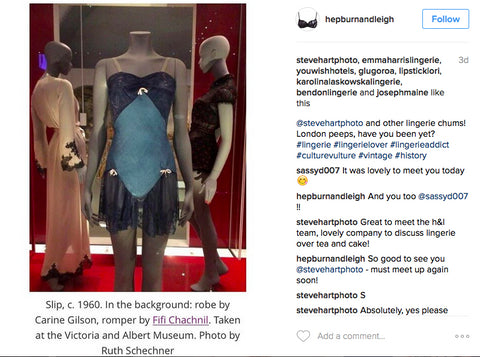I am NOT a morning person. So on Saturday, when we due to meet at the V and A to see the Undressed exhibition about the history of lingerie, I was late, and failed to wear my promised hat. Happily when you turn up wearing an inappropriately short/tight bright red satin Dita Von Teese slip dress and a blue leather jacket people generally work out you're probably the person they were expecting anyway!
Old friends and new joined us for a fairly erratic ramble round the exhibit, with most of us making it for Tea and Thinking afterwards, also some Lowering The Tone. And Scones. It was quite busy, so this is an entirely incomplete and probably incoherent set of notes of just stuff that came up for me, really - and I am definitely not a lingerie academic.
1) Don't go on a Saturday morning if you want to be in a group - it was pretty packed and we kept losing folks!
2) It's surprisingly small. I know lingerie doesn't take up much space, but still, I was reading everything intently on a day when I was tired and brain foggy, and looking at details, and it still only took about 2 hours to be done. For the Serious Lingerista, this may be unsatisfying. I was very pleased that first display is a pair of ornate stockings in which they admit that they have no idea when they look at the first few hundred years of stockings whether they were men's or women's. TAKE THAT, essentialist models of gender and people who fetishize stockings as "true femininity".
3) I was confused by the layout. Maybe I'm just old, but I like things ordered by time, or preferably time and theme - shapewear through the ages, knickers through the ages, that sort of thing. This was ordered more by something mystical, and so, for example, the main case is mostly crinolines and bustles but then inexplicably jumps to frilly 50's knickers and a Wonderbra. Why? Baffling. Plus, I find it hard to think of a Wonderbra as museum-worthy, but I gather the 90's are now vintage so I'm probably just wrong on that score.
4) It's still worth going - for me, just for the complicated embroidered stockings and the stays. Also the knickers with tiny applique lace horses. God, I wish we could make stuff like that.
5) Notable by their absence; all the lingerie between 1920 and now that uses latex. Latex is super hard to maintain. I have dresses I bought 15 years ago that are fine (admittedly they don't fit, but you know, they are structurally sound), but my latex? That disintegrated a while back. So there's ONE example of it in the exhibition, and the rest is the text and adverts about it. Playtex, by the way, is originally all about latex, which amuses me these days when latex is so fetishized and Playtex are so everyday lingerie.
6) The corset displays; ARGH, they are SO peddling the myth that everyone tightlaced and it was terrible for women because it messed up their bodies. Don't get me wrong, I wouldn't want to wear a corset everyday. But as with everything fashion related, what survives is the least worn items, so we have the most extreme corsets that were barely worn, not the daily wear items that smoothed shapes out rather than being very waist reducing, and which weren't worn tightlaced. I mean think about it for a minute - women have been doing heavy duty work like hand washing enormous amounts of laundry (have you ever tried handwashing bedlinen?!) for centuries, do you really think they'd be hauling stuff about in a tiny tightlaced corset? Good grief. As for the whole "it moves your organs around" thing, GET A BIOLOGY BOOK OUT, fashion people. Your internal organs have to shift about. When they get stuck together it really messes with you, because in the course of a day, your digestive system will be variously sized and moving, your lungs are expanding and contracting, all sorts of stuff is going on, and don't even talk to me about wombs and the lunar cycle of growth and shrinkage, or how we can grow a corpus luteum complete with vascular system up to 5cm across in 24 hours. And that's even before we get onto what happens when you're pregnant.
This mini-rant brought to your courtesy of the people I was next to being appalled by the petite size of one of Dita Von Teese's corsets and talking complete cobblers about it.
7) ALSO about corsets; we don't really know what they were like back when they were made. There's a whole era where we talk about them being made from whalebone, which isn't quite accurate - they were made from a bit of a whale in the jaw, called baleen. (No, middle-aged couple that were next to me, they did not kill whales historically just for that. That would be really stupid). It is now illegal (because whales are good, we should definitely keep them) so we have no idea what whalebone was really like when it was actually used in corsets; every example we have now is dried up, cracked and dead. But probably when it was used, it was still moist and springy and therefore mega flexible, and to an extent was kept moist due to close body proximity/sweat etc. This also meant that your corset probably smelled of fish pretty strongly. Granted people used to wear linen underclothes over and under corsets plus many many layers of outerwear, but still, basically, fishy.
This is not covered in the notes.
8) The exhibition focuses on European lingerie and some US stuff. There's pretty much nothing about the whole of the rest of the world. Norway, we would like to thank you for your contribution to the world of undies; fishnet. Some Norwegian genius made undies out of a fishing net (hopefully a clean one and therefore less fishy than baleen corsets), the army then adopted it on the basis that it was economical AND practical (apparently it traps pockets of warm air against the body. Who knew?! I think I'd want merino wool undies in Norway myself), and then the rest of Europe got into in the 50's. It's really hard to underestimate the impact of war on the history of lingerie in the EU, for so many reasons. People tend to gloss over that.
9) You know what else they gloss over? Periods. People used to have less of them, admittedly (age of menarche was higher, greater number of pregnancies, more breastfeeding, poor health, many, many deaths during childbirth and an overall earlier age of death). But an exhibition that covers breastfeeding and maternity garments, but neglects even to mention that their natty red knickers were monthly wear, probably needs to think about why it's ok with talking about babies but not periods.
10) Speaking of how babies become a thing, the whole history of lingerie that is just for sex is also missing. And yet it is by FAR the biggest part of the lingerie industry and in terms of money spent may well always have been.
11) Cor, most people really don't know much about the relationships between brands/companies/factories. Basically, there are lots of brands, but far fewer companies and even fewer factories. So, you might find all your 6 favourite brands are owned by one company, and that they use 2 factories. Lots of brands are actually just licenses, which means the brand name/sometimes certain patterns, logos etc are just farmed out to whichever company makes the best bid for them. This is very true for celebrity lines, but even for really famous stuff like Wonderbra it can happen - Wonderbra was licensed to Gossard in the UK for many years before the parent company took it back in 1994, and Gossard and Wonderbra are now competitors again (I am largely team Gossard).
12) I'm pretty certain KMD intermittent employee Maz is going to grow up and look like Fifi Chachnil.
Also, the security man was good eye candy. But I don't know if he's there every day!



